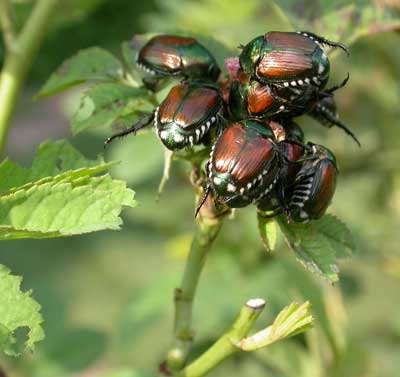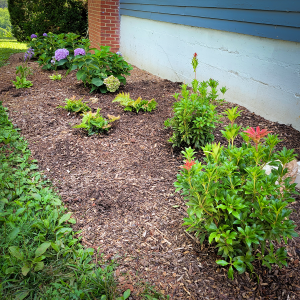
Japanese Beetle—just a pest? or causing serious damage?
The Japanese beetle is found throughout Virginia and has been well established in Virginia since the early 1970’s. They feed on a wide variety of trees, shrubs, and herbaceous plants. They can severely damage the foliage for fruit trees and grapes and can at times be pest of vegetables and field crops. The immature stage, also called a grub or white grub can reach pest status on many varieties of grass grown for turf in Virginia.
The adult of the Japanese beetle is bright metallic green and is about 3/8 inch long. It is smaller then the Green June beetle which is over ¾ inch long. The Japanese beetle wing covers are coppery colored and there are a series of tufts of white hairs on the abdomen. The larvae of the Japanese beetle are similar to other species of white grubs and have an off-white body with a brown head. They curl into a C-shape when not active. Japanese beetles larvae have a distinctive v-shaped row of spines on the end of the abdomen.
Damage from Adult Beetle: Japanese beetles chew small holes in leaves between the leaf veins. This damage gives the leaves a lacy appearance and is called skeletonizing. They will also feed on fruit and buds. Heavily damaged trees and plants will take on a brownish cast as leaves shrivel and die
Damage from the larvae: The immature Japanese beetles or grubs feed just below soil surface on the roots and lower sections of the plant. Damaged truf at first becomes dis-colored and later turns brown as if it suffering from drought. Damaged turf can often be pulled back like a piece of carpet exposing the grubs. In general densities of 6-7 grubs per square foot are needed to cause noticeable damage. Yards with high populations of grubs will have many large brown patches
Damage and Life History: Adult Japanese beetles start emerging from the ground in late June and most are out by mid July. The beetles feed and the females start releasing a pheromone that attracts the males. After mating the females dig small burrows in the soil and lay eggs. Egg laying lasts from mid July to mid August. Eggs require moisture to expand and develop and hatch in in 8-9 days. Immature grubs feed and develop until the soil starts to cool in the fall. At this point they burrow down about 4-8 inches and stop feeding. In the spring when the soil temperaturs start to warm, the grubs move up and start feeding again. The grubs reach full size in late May or early June and pupate. Adult beetles emerge several weeks later and complete the cycle.
Controlling the Japanese Beetle
Drought conditions in late July and early August will cause poor establishment of Japanese beetles and will reduce damaging populations for the following year.
Trapping using commercially available traps with lures can be effective but can also draw beetles into the yard that might not have otherwise come into the area. Place the traps at least 30 feet away from plants that you wish to protect.
Hand picking only works in isolated cases. Drop beetles into soapy water and dump out after they drown.
Nematodes, specifically entomophagous nematodes, can be very effective on controlling the white grub stage of this beetle. Use preparations containing Heterorhabditis spp., and apply them in mid-August. Irrigate with about ¼ inch of water both before and after application of the nematodes.
Chemical controls
For Turf: Apply a registered insecticide in late July or early August when grubs are small and before damage becomes extensive. Applications at other times of year are much less effective.
For Fruit Trees: Follow the spray schedule for fruit trees using insecticides specifically labeled for fruit trees. Follow the wait period indicated on the label before harvesting fruit.
For Ornamental trees and shrubs and herbaceous plants: Apply a systemic insecticide such as imidacloprid in May or June. Use a soil drench in the early part of the growing season so the insecticide is present when the beetles begin feeding later. Systemic insecticides applied after the beetles start feeding in late June will be less effective. Contact insecticides will kill beetles present at application. Beetles in rose blooms are rarely controlled.
These plants are less likely to be attacked: arborviteae, ash, boxwood, cedar, dogwood, euonymus, fir, forsythia, holly, juniper, lilac, magnolia, pine, privet, red oak, red and silver maple, red mulberry, spruce, and yew. Netting can be used to cover small plants but must be left on for most of the summer and may restrict growth and damage the plant that is being protected.
Dos Amigos Landscaping can help you control the Japanese Beetle and the damage it causes. Contact us today to find out more: 434-465-0075 or send us an email.
Originally written by: by Eric Day, Pete Schultz, Doug Pfeiffer and Rod Youngman. Reprinted courtesy of Virginia Cooperative Extension, www.ext.vt.edu


